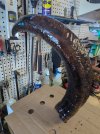Horsewright
Knifemaker / Craftsman / Service Provider
- Joined
- Oct 4, 2011
- Messages
- 13,743
I was wondering if anyone had some suggestions on cutting these guys up? I cut a lot of sheep and goat horn many years ago but I don't remember how I did it. I do remember wasting a lot before I got it down and that's what I'm trying to avoid this time.
I mostly would be looking for 3"x1"x 3/16 to 1/4" scales as I make mostly smaller knives.



Any ideas or suggestions? Thanks.
I mostly would be looking for 3"x1"x 3/16 to 1/4" scales as I make mostly smaller knives.



Any ideas or suggestions? Thanks.

